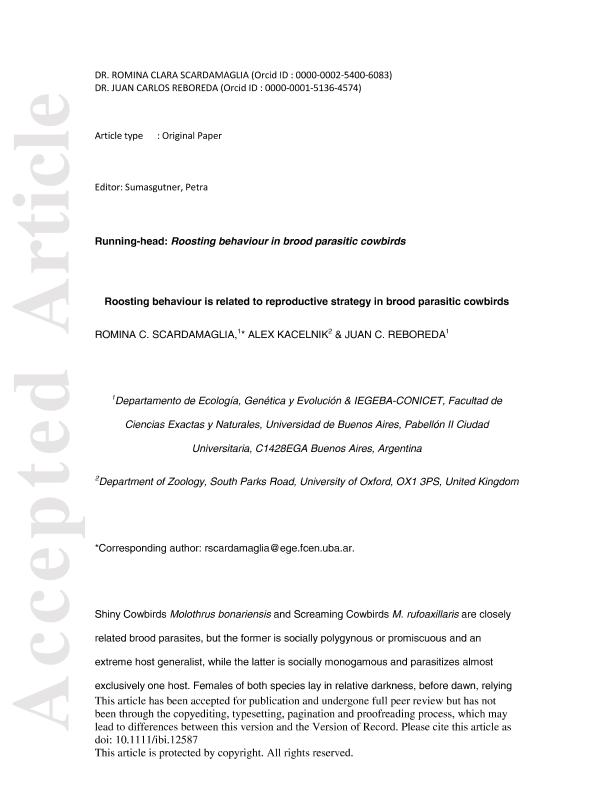Artículo
Roosting behaviour is related to reproductive strategy in brood parasitic cowbirds
Fecha de publicación:
10/2018
Editorial:
Wiley Blackwell Publishing, Inc
Revista:
Ibis
ISSN:
0019-1019
Idioma:
Inglés
Tipo de recurso:
Artículo publicado
Clasificación temática:
Resumen
Shiny Cowbirds Molothrus bonariensis and Screaming Cowbirds Molothrus rufoaxillaris are closely related brood parasites but the former is socially polygynous or promiscuous and an extreme host generalist, whereas the latter is socially monogamous and parasitizes almost exclusively one host. Females of both species lay in relative darkness, before dawn, relying for host nest location on previous days’ prospecting activity, or possibly on following better-informed roost associates. We studied the temporal and spatial patterns of roosting behaviour in these species to test the hypothesis that roosting behaviour of cowbirds is related to their breeding strategy (brood parasitism) and reflects differences in strategies between species. We recorded fidelity to a roost, location fidelity within a roost, inter-individual spatial associations and timing of roost departures and parasitic events, using tagged individuals. Female Shiny Cowbirds and both sexes of Screaming Cowbirds showed marked fidelity in roosting location, and roost departures occurred both during and after the known time window for parasitism, with earlier departures probably corresponding to laying days. Screaming Cowbird females and males that were trapped together and showed high levels of association during the day, also showed high levels of association in the roost. We describe the spatial and temporal patterns of a relatively poorly known aspect of avian ecology in general and the behaviour of brood parasites in particular.
Palabras clave:
BIRD ASSEMBLAGE
,
MOLOTHRUS
,
RADIO-TRACKING
,
SITE FIDELITY
,
SPACE USE
Archivos asociados
Licencia
Identificadores
Colecciones
Articulos(IEGEBA)
Articulos de INSTITUTO DE ECOLOGIA, GENETICA Y EVOLUCION DE BS. AS
Articulos de INSTITUTO DE ECOLOGIA, GENETICA Y EVOLUCION DE BS. AS
Citación
Scardamaglia, Romina Clara; Kacelnik, Alex; Reboreda, Juan Carlos; Roosting behaviour is related to reproductive strategy in brood parasitic cowbirds; Wiley Blackwell Publishing, Inc; Ibis; 160; 4; 10-2018; 779-789
Compartir
Altmétricas




